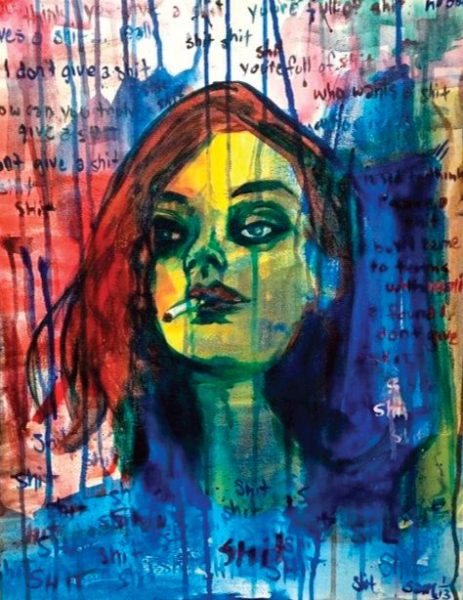We’ve all heard the dos and don’ts of writing instruction: show, don’t tell; don’t get bogged down describing the weather; don’t begin a story with the narrator/character thinking (in other words put us IN a scene); refrain from starting a story with dialogue. Yet you hit the ground running with a spoken line, and it works effectively, I think, in plunging the reader immediately into the dilemma of “lost.” How much of a rule follower are you?
I don’t worry overmuch about following rules. As long as what I’ve written doesn’t throw up any huge red flags for me, I’ll let it go, at least to a first reader.
What spurred this story? By that I mean what, if any, particular snippet of it “came first”? The item, for instance, about the dog, patient and alone in space, broke my heart—I wonder if that came early or late in the development of this story. How much revision, do you estimate occurred between your first and final draft? How many versions, or how much time passed before your first and final draft of “Dispatches”?
This story developed out of my interest to hold in a stationary place two people who rely on movement to get through the day. That was the goal: to see how the tension of stasis would work on them. Everything else grew out of that.
I would estimate that this story went through six significantly different drafts. I think I wrote the first part of this about a year ago and then put it aside for six months or so. The dog didn’t make an appearance until at least the fourth draft.
Have you ever been to Iceland? Had a car break down in the middle of nowhere? Had a cantankerous girlfriend? In other words, talk about the real-life influences on this story, if any.
I have been to Iceland, and I have driven through the island’s interior, which is a fantastically weird place.
My wife and I circumnavigated Iceland in a small van/truck that we called “The Bread Truck.” I think it was a Citroen. I drove it to some places that definitely tested its limits (lots of very bumpy dirt roads up mountains to see glaciers), and it held up like a champ, which is to say that we didn’t get stuck anywhere. Also, it never got really dark while we were there, and I mean that as both a report on the fact that we were there in early summer (so the sun never truly set) and also as a metaphoric comment on the status of our relationship.
Our trip was wonderful, and the singularity of the place stuck with me. I’ve been trying to find a way to work it into a story ever since.
I think of this as an iceberg story—so much of the relationship, and what has come before and what will happen afterwards, and what they mean to say to one another, never hit the surface, yet it’s all right there, boiling underneath. How hard do you have to work at achieving that? Are you aware of it as you are doing it? Do you recognize you’ve done it in the finished product? Is this typical of other stories of yours?
I was trying very hard to capture a moment of extreme frustration and worry in a way that felt real, so for me, that meant that the characters would talk around the really important things. I think this is pretty common in life, and it’s common in much of my writing. I make an effort to write dialogue that feels real but that has a kind of echo to it. In the end, the struggle for me is to figure out if I’ve given enough information to let the story expand, or echo, after it’s finished. Being too coy is just as bad as giving it all away.
Is flash your preferred medium for writing? For reading? If not, what do you usually write? What do you usually read? What’s the last thing/story/book/poem/cereal box you read? Did you like it? Why or why not?
This is the first short piece that I’ve published. Most of my other stories are eight to fifteen pages.
I read pretty widely, I think. I’m currently teaching a class at University of Hawai’i at Manoa called Representations of Work and Workers in Twentieth Century American Fiction (what a mouthful), so I’ve been trying to read a lot of novels about workers, the labor movement, things like that. I recently read a somewhat obscure text by a writer named Alexander Saxton. The book was called Bright Web in the Darkness, and it dealt with a number of working-class folks around the time of WWII. One of them is an African-American woman trying to get in the ship welder’s union, one is a labor lawyer who may have just sold out the workers he once fought for, and the other is a Navy seaman who finds it really hard to feel at home anywhere in the world. It’s a pretty good book, one that embodies Chekhov’s claim that the artist’s job is to ask questions, not answer them.



 The core workshop of SmokeLong Fitness is all in writing, so you can take part from anywhere at anytime. We are excited about creating a supportive, consistent and structured environment for flash writers to work on their craft in a community. We are thrilled and proud to say that our workshop participants have won, placed, or been listed in every major flash competition. Community works.
The core workshop of SmokeLong Fitness is all in writing, so you can take part from anywhere at anytime. We are excited about creating a supportive, consistent and structured environment for flash writers to work on their craft in a community. We are thrilled and proud to say that our workshop participants have won, placed, or been listed in every major flash competition. Community works.